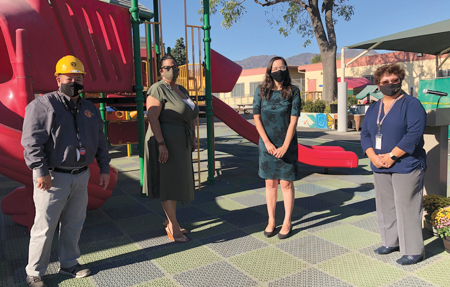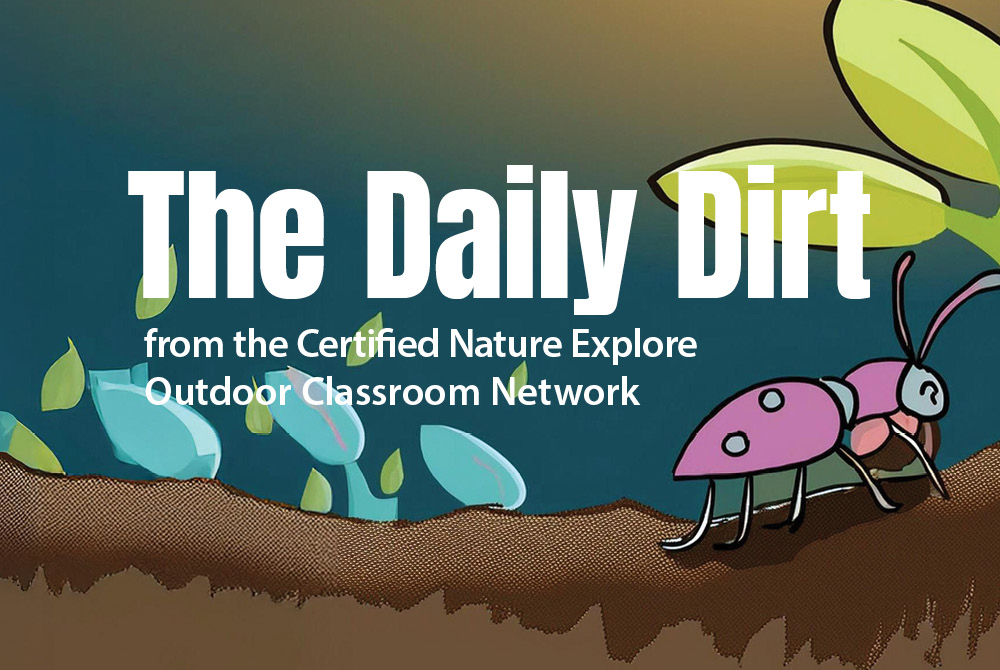Many studies over the years have found that families living in urban environments are forced to use their attention on awareness, instead of enjoyment and creativity. Kaplan and Berman’s research in 2010 and 2015 found that natural environments help restore focus and provide opportunities for increased attention. Focusing attention is a critical developmental milestone for young children preparing for kindergarten, so outdoor spaces are critical to a child’s overall development.
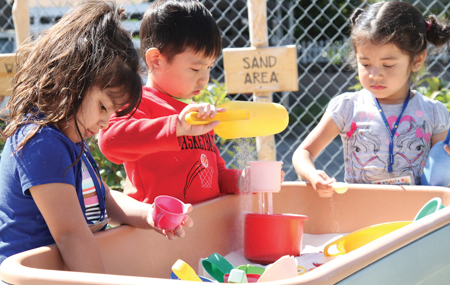
Nature Explore Classrooms are intentionally designed with distinct areas for different activities, such as playing with sand. [©Los Angeles Unified School District]
As we continued building outdoor classrooms at sites throughout the district, members of the early childhood education division met with parents, principals, mental health consultants and teachers in order to discuss the impact the outdoor classrooms have had on their children. Each group of stakeholders was able to articulate the benefits for their children of time in nature classrooms.
Digging for Bugs: Parent Responses
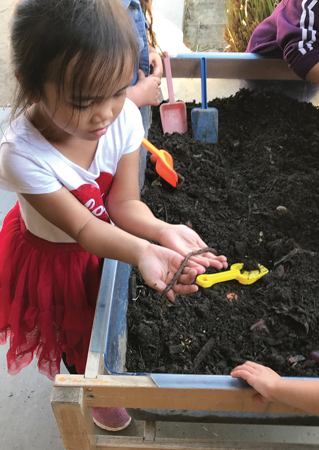
Working with dirt encourages calm concentration. [©Los Angeles Unified School District]
When families have the opportunity to observe their children in the mud pit and digging for bugs, they quickly understand and appreciate the value of play and the learning that takes place in the Nature Explore Classroom. Interviews also show that children’s attitudes about going to school changed. During one of his visits to a Nature Explore Outdoor Classroom, LAUSD’s chief facilities director Mark Hovatter stated, “A little child came to me and asked me why I was coming to their park?” This child’s perspective is an important piece as many children do not see their campuses as learning centers, but as parks where learning occurs.
One parent noted that her children are curious about insects and their impact on the environment. They ask her questions, and when she cannot answer their questions, they look up the information on the internet and have a discussion about it. The family is learning together! Many families have extended the learning at home by creating gardens, taking nature hikes and engaging in conversations about the “noticings” they have when outdoors. They are taking time to listen to the sounds in their environment and enjoy the beauty outdoors.

Making music in nature activates the senses and engages the whole body. [©Los Angeles Unified School District]
Many parents who have participated in centers with NEOCs have taken their learning home by creating gardens in small spaces, discussing nature on walks with their children, and incorporating natural objects in their indoor and outdoor play. Children run to smell the flowers and observe insects and worms in their environment. They understand the connection to sustaining the environment. Teachers have also made connections through virtual learning, by teaching from the NEOC to support children’s emotional well-being. A teacher at Brooklyn EEC connected with her students through the grapevine growing in their garden. They discussed size, color, shapes and length of vines that they observed. This lesson was conducted throughout the month, with students excited to chart the growth and changes they observed.
Nature Classrooms and Special Education
Our interviews also included the examination of the relationships between other early educational professionals who worked at these sites. We were able to connect with principals, teachers, and mental health consultants. For example, the preschool special education teacher at Glassell Park EEC noticed the immediate effects the environment has on her students. Her class is called Preschool for All Learners Collaborative Classroom. Ms. Conley reports,
“As the PAL/CC teacher at Glassell Park EEC, I spent a great deal of time outdoors with the students. This aligns with my own philosophy of education. Therefore, I have always sought to maximize my students’ interactions with the natural world. It is a dream job. Having spent many years as a substitute teacher at a school in Boyle Heights, where the entire environment was concrete and steel, I was immediately struck by the light-heartedness and joy that I witnessed upon my move to Glassell Park EEC. The natural environment produces a more relaxed atmosphere among the staff and the students, without sacrificing attention to professionalism and the preschool learning foundations.”
The increased exposure to natural environments mentioned by Ms. Conley is another example of how ART therapy becomes naturally embedded into these locations. The idea that she felt the joy and relaxed atmosphere is also a testament to the efforts by the principals at these locations.
ADVERTISEMENT
The Mental Health Connection
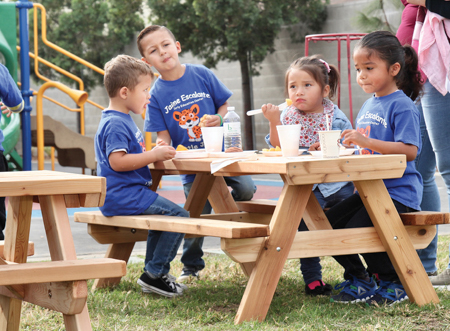
Even snack time takes a special flavor outdoors. [©Los Angeles Unified School District]
“We have observed that the calm outdoor environment has also benefitted the staff, as it provides great opportunities for the staff to ground themselves through the use of all their senses, enhancing the ability to be present to support the students. The NEOC also offers opportunities for staff to use it as a form of positive distraction, when supporting the students with self-regulation.”
The View from the Principal’s Office
Viken Kazarian, principal at Arminta Early Education Center, stated that he has seen a difference in the behaviors of children who have access to a Nature Explore Classroom and those who have the traditional asphalt playground. He explained that children in the NEC are engaged and show interest in activities both indoor and outdoor, whereas those in asphalt environments lacked engagement with materials and activities and have a difficult time staying on task.
Ernestine Lara, principal at Escalante EEC, said, “I have witnessed how children’s challenging behaviors de-escalate when they are in our Nature Explore Classroom. It is amazing to observe the difference and impact that nature makes on our students. A child who is angry or sad and may be having a rough day inside of the classroom immediately transforms to an explorer of nature once the door opens and they see our beautiful outdoor environment.”
Once outdoors, students are able to investigate the natural world. Principal Lara added, “I cannot say they had one favorite thing to do, because I have observed students engaged in watering the plants, building with logs, stacking rocks, collecting leaves, creating with loose parts, sharing magnifying glasses to look at the insects, and exploring the feeling of mud on their hands.”
Another principal describes an active child that had difficulty engaging in activities inside the classroom but who, when outside in the Nature Explore Classroom, became an avid “rock collector.” Each day he searched for, as he called them, “interesting rocks.” He talked about their size, shape, color and weight as he continued to collect them. He was engaged and focused and was excited to share his rock collection with everyone.
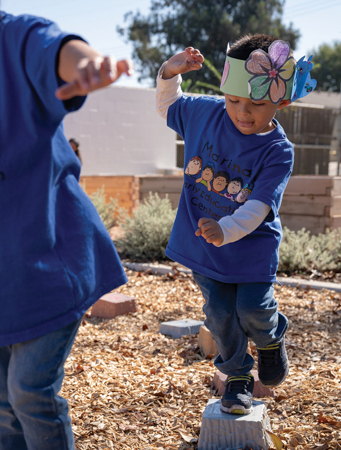
[©Los Angeles Unified School District]
Conclusion: We Will Not Stop There
Teachers and staff at the district’s Nature Explore sites are often found eating lunch and walking around outside. You can regularly observe them during their breaks and lunch periods relaxing in the peaceful environments. Many of them have stated they use the park-like outdoor spaces to de-stress. During the pandemic and the subsequent closure of the district’s 86 early education centers, a staff member at Escalante EEC reduced her stress by maintaining the outdoor classroom. She would begin each day at the center walking and beautifying the gardens by planting seeds, pulling weeds, and watering.
“I hope my work here will make the kids happy when they return, and I am anxiously awaiting a return to normalcy,” she said.
During regular operation, parents can often be seen relaxing outside in small groups or by themselves, as they watch their children get in their last opportunities for play before heading home. The staff member at Escalante EEC added, “Nature has a calming effect on the body as you take in the beauty, fragrant breeze and sounds around you.”
Since 100 percent of the preschool children in the district’s programs qualify because of an identifiable need, it has been critically important that these preschool children have an opportunity to play and learn in a natural environment. Coupled with COVID-19 and the fact that LA Unified is a vast, urban district covering 710 square miles, children are spending less time exposed to natural environments. However, the district’s early education programs continue to push back against this trend. In turn, children are developing attention restoration, cognitive growth, and physical development from participating in these programs. There are also long-term behavioral benefits associated with each of these, as children carry these attributes into adulthood. The importance of what the parents and early education professionals shared will continue to inform the division’s work moving forward, as we work to bring an outdoor classroom to each of our centers.
In closing, we are looking to broaden our programs, so that every child in an early education center will have the opportunity to experience a nature-based learning environment.
“Safe places for children to learn and play is a right that all children should have,” says Dean Tagawa, executive director for the early childhood education division. “We have completed 11, broken ground on the next three, and planned the next 22 sites. And we will not stop there!”
Reference
Berman, M., Jonides, J., & Kaplan S. (2008). The Cognitive Benefits of Interacting with Nature. Psychological Science.
Related
ADVERTISEMENT





